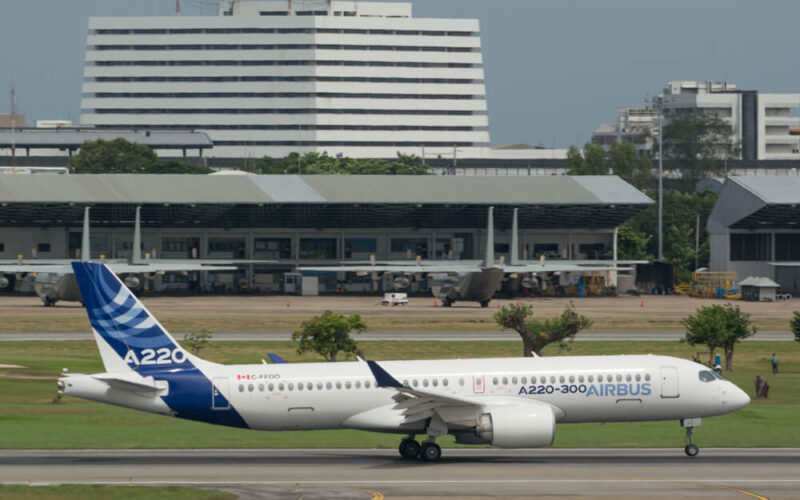As Airbus, paired with airBaltic, departed for a demonstration tour of the A220 around Asia-Pacific on October 27, 2019, the aircraft is seemingly gathering its first fans. The former-CSeries jet has been noticed by Qantas Chief Executive Officer, Alan Joyce, who said that the A220 is a “very good aircraft” when he attended the A220’s visit in Sydney.
Most importantly, the Australian flag carrier has hinted in 2018 that Qantas is looking at options to renew its domestic and regional fleet, which is operated by its subsidiary, QantasLink.
Currently, QantasLink has 84 aircraft registered to its name – two Airbus A320, 20 Boeing 717, 45 De Havilland Canada Dash 8 variants and 17 Fokker F100 jets. The average age of the aircraft is 16.9 years and by far the oldest type is the F100 – no Fokker jet in the airline’s fleet is younger than 25 years old, planespotters.net data shows.
Is the A220 a good fit for Qantas and its subsidiary, QantasLink?
Measuring A220 for Qantas
Realistically, there are two possible options to replace the 717 and the F100 – either the Airbus A220 or the Embraer E2 jet family.
Qantas’ seat map website reveals that the airline’s 717s are configured in two ways: one is an all-economy layout, able to seat 125 passengers, while the other layout includes 12 business and 98 economy seats. The Fokker F100 jets are configured in an all-economy with 100 seats available to passengers.
The A220-100 seats between 100 and 120 passengers, while the -300 has a capacity of 120-150 passengers in a typical 2-class configuration, according to Airbus.
As of June 30, 2019, Qantas Domestic flights, operated by various aircraft, including the 737-800 and Airbus A330 (which the airline cross-utilizes both the 737 and the A330 across on domestic and international flights on its network), averaged a load factor of 77.8%, according to the latest financial report released by Qantas.
In Q2 of 2018, the carrier moved two Airbus A320 aircraft from Jetstar to QantasLink to “optimize capacity to match demand”. Yet overall, Available Seat Kilometers (ASK), a figure to measure an airline’s capacity, has been shrinking over the past four years at Qantas Domestic, the carrier’s data book shows. In FY2019, ASKs measured at 33.8 million, while in FY2014 the number was 37.8 million.
Back in 2018, when the airline hinted at the fact that it is studying various aircraft for its needs, the Chief Financial Officer, Tino La Spina told Australian Aviation that Qantas looks at three factors for new aircraft: profitable routes, flexibility to operate on various routes and the ability to stay competitive in certain markets.
Nevertheless, if we assume the 77.8% load factor is also present on Qantas’ 717s and F100s, this means that the A220 would still be profitable for the airline. During the Paris Air Show 2019, airBaltic’s CEO, Martin Gauss, mentioned that the break-even point for the A220-300 is at 90 passengers – because the Latvian airline configures its former-CSeries aircraft in a 145 seat layout, the load factor to break-even is at 62%.
Judging by the fact that Qantas has much less competition on its domestic routes and realistically only competes with Virgin Australia and Tigerair, both of which operate the 737s or the A320s (except eight ATR 72-600 turboprops flown by Virgin Australia), compared to airBaltic’s environment, where low-cost carriers are thriving, the Airbus A220 makes a lot of sense for the Australian flag carrier. The aircraft has the operational flexibility to operate on thin routes, as the combination of its range and break-even factor allows the A220 to do so. Furthermore, Airbus itself has highlighted that the A220 will fulfill all the needs of Australian airlines, as it is able to fly between any point in Australia, as well as non-stop flights to the Pacific islands.
However, before deciding on its regional and narrow-body fleet’s future, Qantas’ CEO, Alan Joyce has highlighted that one thing is not right with the aircraft – the price.
“What Airbus have to get right is the pricing of the aircraft”, Joyce said, as reported by Australian Aviation.“As it was priced before it was very high so for us to buy it so has to be a lot cheaper than the prices we’ve been seeing”.

